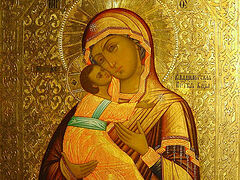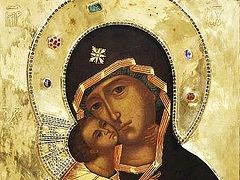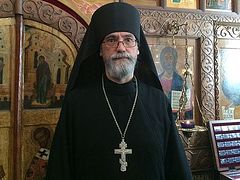In the name of the Father, and of the Son, and of the Holy Spirit!
Dear brothers and sisters in Christ, every church feast is largely connected to a particular historical event of the past. All feasts are given to us not only so that we may venerate them or solemnly commemorate them—which is also very significant—but most importantly, so that we may draw important and beneficial lessons from them for the future.
The image of the Vladimir Icon of the Mother of God, which we especially venerate today, is not merely a church feast—it is a celebration of deep significance for the history of our country. On this day, we commemorate the miraculous deliverance of our country from the aggressive expansion of Khan Akhmat. There is no need to delve into the historical aspects or examine that particular event in detail. What is important for us as believers is to highlight the main point: that every time our state stood on the edge of disaster, divine intervention—through the prayers of the Mother of God—saved us from imminent destruction. If it were not for Her special protection, if not for the prayers of the saints, if not for the firm faith of our forefathers, it is quite possible that we would no longer be gathering here in church for worship, and most likely our state would have ceased to exist long ago.
When our state stood on the brink of ruin, divine intervention—through the prayers of the Mother of God—delivered us from destruction.
How many military campaigns have there been, revolutions, diseases, epidemics—yet our nation, like a phoenix, always rose from the ashes. And of course, one is led to the thought that this is not only the merit of our great tsars, warriors, and people, but also a sign of God’s special care for our nation through the prayers of the Most Pure Virgin Mary.
On one condition will the Lord always be with us—if we preserve the faith and our spiritual values; if we do not cave into sin and stand firm in defending our spiritual culture. A great mission lies before us. We must be true bearers of the Spirit of God, to serve as an example to others—for faith is known by deeds. The Mother of God, who appeared to St. Seraphim of Sarov, would always say of him: “He is of our kind.” But are we kindred to God? Are we Christians in spirit or only in name? For history also knows the reverse—when our people stumbled, divine grace departed from them, and enemies overcame them—a vivid example of which is the Mongol-Tatar yoke. All these lessons were not in vain; all this was needed for us to understand that without God we are nothing. The Mother of God, of course, is always quick to help, always ready to assist—but She also expects a response of love from us: that we become God’s friends, that we be called the children of God. We must strive to imitate God, the Theotokos, and the saints.
Many people believe that salvation lies solely in ritual observance—which is not insignificant in itself. Many stop at ascetic labors and long prayers, but if all of this does not teach us the most important thing—love—then all our efforts remain a dead letter of the law. If we truly want to succeed, it is important for us to adopt not only the way of life but also the way of thinking of God, of the Mother of God, and of all the saints. There is much—if not everything—we can learn from our Mother, the Theotokos. What a bright mark She left in human history! Her humility, meekness, gentleness, purity of soul and body are given to us as a lesson and example. We must not only admire Her but strive to be like Her.
She takes special care of all who imitate Her. Therefore, dear brothers and sisters, if we want world events to change, if we see that the world is sinking further into darkness, we need not sigh, worry, or despair—we simply need to begin changing ourselves for the better, imitating the Mother of God. Then the world around us will change for the better, and with our personal effort of selfless love, we will help both ourselves and our country and be true defenders of our nation.







